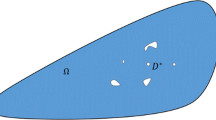Abstract
The general construction for finding all “essentially different” nonlinearities in equations of mathematical physics is exemplified by the inverse problem of the Grad–Shafranov equation. We present an algorithm that allows one to recover relatively fast all essentially different sought-for nonlinear right-hand sides of the Grad–Shafranov equation. We present the first example of a domain with smooth boundary for which the inverse problem has at most one solution in the class of affine functions, and also in the class of exponential functions. We select some subset of simply connected domains that model, in some sense, the so-called doublet configurations, for which the inverse problem has at least two essentially different solutions in the class of analytic functions. In the concluding subsection of the paper, we indicate a method of recovery, from boundary data, of all essentially different nonlinearities in equations of mathematical physics of considerably general kind, which includes a system of equations that describes combustion and detonation processes.
Similar content being viewed by others
References
V. K. Andreev, O. V. Kaptsov, V. V. Pukhnachov, and A. A. Rodionov, Applications of Group-Theoretical Methods in Hydrodynamics, Kluwer (1998).
S. I. Bezrodnykh, V. I. Vlasov, and A. S. Demidov, “The inverse problem of the Grad–Shafranov equation,” in: Int. Conf. “Contemporary Problems of Mathematics, Mechanics, and Their Application,” dedicated to the 70th Anniversary of the MSU Rector Academician V. A. Sadovnichy, Moscow, March 30— April 2, 2009. Proceedings, MSU, Moscow (2009), p. 132.
A. D. Valiev and A. S. Demidov, “Nonnegative trigonometric polynomials with fixed mean passing through given points,” Math. Notes., 62, No. 3, 390–392 (1997).
A. S. Demidov, “On the inverse problem for the Grad–Shafranov equation with affine right-hand side,” Russ. Math. Surv., 55, No. 6, 1141–1142 (2000).
A. S. Demidov, “On reconstruction of polynomial nonlinearities in equations of mathematical physics,” in: Int. Conf. “Differential Equations and Related Topics” dedicated to Prof. I. G. Petrovskii. Book of Abstracts, Moscow (2007), pp. 73–74.
A. S. Demidov and L. E. Zakharov, “Direct and inverse problems in the plasma equillibrium theory,” Russ. Math. Surv., 29, No. 6, 203 (1974).
Yu. A. Dubinskii, “Nonlinear elliptic and parabolic equations,” in: Itogi Nauki: Sovremennye Problemy Mat., 9, VTNITI, Moscow (1976), pp. 5–130.
I. N. Zverev and N. N. Smirnov, Gasdynamics of Combustion [in Russian], Izd. Mosk. Univ., Moscow (1987).
A. N. Kolmogorov and V. M. Tikhomirov, “ε-entropy and ε-capacity of sets in functional spaces,” Am. Math. Soc., Transl., II. Ser., 17, 227–364 (1961).
R. Courant, Partial Differential Equations, Interscience, London (1962).
Y. L. Luke, The Special Functions and Their Approximations, Academic Press, San Diego (1969).
G. Polya and G. Szegő, Problems and Theorems from Analysis, Springer, Berlin (1972).
A. D. Polyanin and V. F. Zaitsev, Handbook of Nonlinear Partial Differential Equations, Chapman and Hall, CRC Press, Boca Raton (2003).
V. M. Tikhomirov, Some Questions in Approximation Theory [in Russian], Izd. Mosk. Univ., Moscow (1976).
A. N. Tikhonov and A. A. Samarskii, Equations of Mathematical Physics, Dover, New York (1990).
E. Beretta and M. Vogelius, “An inverse problem originating from magnetohydrodynamics,” Arch. Rational Mech. Anal., 115, 137–152 (1991).
E. Beretta and M. Vogelius, “An inverse problem originating from magnetohydrodynamics. II. The case of the Grad–Shafranov equation,” Indiana Univ. Math. J., 41, 1081–1118 (1992).
E. Beretta and M. Vogelius, “An inverse problem originating from magnetohydrodynamics. III. Domains with corners of arbitrary angles,” Asymptotic Anal., 11, 289–315 (1995).
J. Blum and H. Buvat, “An inverse problem in plasma physics: The identification of the current density profile in a tokamak,” in: L. T. Biegler, T. F. Coleman, A. R. Conn, and F. N. Santosa, eds., Large-Scale Optimisation with Applications. Part I: Optimization in Inverse Problems and Design, Springer, New York (2002), www.inria.fr/rapportsactivite/RA2002/idopt/bibliographie.html.
A. S. Demidov, “Sur la perturbation ‘singulière’ dans un problème à frontière libre,” in: Proc. Conf. “Singular Perturbations and Boundary Layer Theory” held in Lyon, 1976, Lect. Notes Math., Vol. 594, Springer (1977), pp. 123–130.
A. S. Demidov and M. Moussaoui, “An inverse problem originating from magnetohydrodynamics,” Inverse Problems, 20, 137–154 (2004).
A. S. Demidov, V. V. Petrova, and V. M. Silantiev, “On inverse and direct free boundary problems in the theory of plasma equilibrium in a Tokamak,” C. R. Acad. Sci. Paris. Sér. I, 323, 353–358 (1996).
S. I. Pokhozhaev, in: M. Chipot, ed., Handbook of Differential Equations Station, Vol. 5, Elsevier, Amsterdam (2008), pp. 49–209.
V. D. Pustovitov, “Magnetic diagnostics: General principles and the problem of reconstruction of plasma current and pressure profiles in toroidal systems,” Nucl. Fusion, 41, No. 6, 721–730 (2001).
V. D. Pustovitov, “Theoretical principles of the plasma-equilibrium control in stellarators,” Rev. Plasma Phys., 21, 1–201 (2001).
Y. Suzuki, H. Yamada, N. Nakajima, K. Watanabe, Y. Nakamura, and T. Hayashi, “Theoretical considerations of doublet-like configuration in LHD,” Nucl. Fusion, 46, 123–132 (2006).
M. Vogelius, “An inverse problem for the equation ∆u = −cu−d,” Ann. Inst. Fourier, 44, 1181–1209 (1994).
L. E. Zakharov, The Theory of Variances of Equilibrium Reconstruction, http://w3.pppl.gov/~zakharov (2007).
Author information
Authors and Affiliations
Corresponding author
Additional information
Translated from Trudy Seminara imeni I. G. Petrovskogo, No. 27, Part I, pp. 75–125, 2009.
Rights and permissions
About this article
Cite this article
Demidov, A.S., Kochurov, A.S. & Popov, A.Y. To the problem of the recovery of nonlinearities in equations of mathematical physics. J Math Sci 163, 46–77 (2009). https://doi.org/10.1007/s10958-009-9658-x
Published:
Issue Date:
DOI: https://doi.org/10.1007/s10958-009-9658-x



